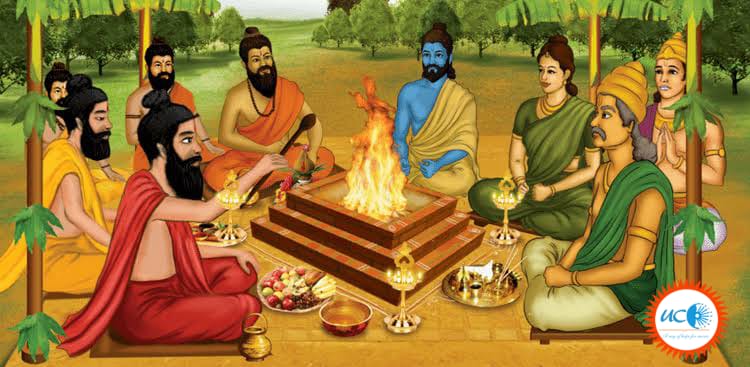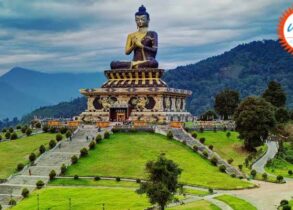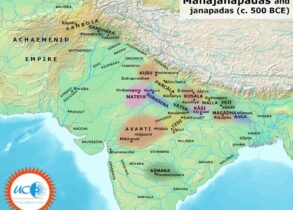Rig Vedic Society
The decline of the cities of Harappan valley civilization can be roughly traced to 1400 BC. The next major civilization in the ancient india is the vedic age, spanning over the period from 1500 bc to 600 bc. The Aryans were originally from the steppes region, from where they migrated to central asia.
Later, they entered into india from the north western region around 1500 bc. The Aryan migration to india took place in several waves in the northwestern mountains. The Kassite inscription from Iraq, Mitanni inscription from Syria ,Hittite inscription are important sources where the word “Aryan” is mentioned. We also come to know about Aryans from rig veda, zend avesta and homer’s odyssey.
The vedic period can be divided into 2 phase:-
- The early vedic or Rigvedic (EVP) ( 1500 bc to 1000 bc)
- Later vedic age(LVP) (1000 bc to 600bc).
RIG VEDIC PHASE
The Aryans during this time were mostly confined to the indus region. The rig veda mentioned the word “saptasindhu” (Lnad of Seven Rivers).The hymns in rig veda provide several crucial information about the social, political and cultural life of rig vedic people.
TRIBAL CONFLICT:
- Between dasas/dasyus and later Aryans.
- Dasas – early Aryans who migrated. The later Aryans who migrated subdued them militarily.
- Dasyus- locals of indus region. They were militarily subdued by both early Aryans and later Aryans.
- Later intra Aryan conflict between the panchajana ( five major tribal groups)
POLITICAL STRUCTURE:
- The political organization was monarchical.
- The tribal polity was led by the tribal chief (rajan) who fought wars for cattle (an important source of wealth during this time), and was also vested with responsibility of protecting the entire village.
- There was no concept of standing army and during wars the entire village participated.
- Kingship was hereditary in nature and the chief or king enjoyed a position of pre-eminence in the tribe.
ADMINSTRATIVE DIVISION-
- kula or patriarchal family was the lowest unit of rig vedic society and jana was the the largest social unit.
- The social grouping by ascending order- kula- grama- visu-jana- janapada.
- The grama was headed under gramini and visu under visapati. Gopa headed one jana and together all jana came to form janapada or tribal kingdom which was placed under rajan. Example of tribal kingdom- Matsyas, purus, yadus and bharatas.
ADMINSTRATION:
- Sabhas and samitis were popular assemblies.
- The functioning of these assemblies were more democratic.
- Sabha- assembly of elders who advised the king on administration. It was placed under the head of sabhapati
- Samiti– assembly of common people. Dealt with political business of state and aslo elect the king . ‘pati’ headed the samiti.
- Women also participated in the sabha and samiti.
- Tax collection was very limited as the economy was mainly pastoral and not food producing.
- Bali was the voluntary offerings from the people received by the chief which was collected by balisadhaka.
ECONOMIC:
- Pastoralist and cattle-rearing
- Cow important source of wealth. Used for its milk, skin and food and not for ploughing fields.
- Gavisthi– cow gifts made to priest
- Concept of private land was not prevelant
- Practiced agriculture, but not intensively.
- no urbanization during this time
- no use of brunt bricks
- mud settlement.
- Pottery type- PGW, Ochre colored pottery
- Art and craft production had still not matured.
SOCIAL-
- Patriarchal family structure and patrilineal mode of inheritance
- Widow remmariage allowed.
- Levirate was prevalent.
- Child marriage was not practiced
- Slavery practiced in rig vedic society, women slaves gifted to priests for domestic purpose.
- Untouchables not mentioned in rig vedas.
- Social differentiation existed, but not rigidified or heritable like caste system.
- Society was largely egalitarian.
RELIGION-
- Natural forces like earth, fire, wind rain were worshipped by personifying them into deities.
- Indra who also goes by the name purandara was the main deity. Other important dieties example- agni, varuna, soma. Female deities like ushas and
- Practised creamation
- No idolatory or temples.
LATER VEDIC AGE
The major sources of information about LVP comes from the other three vedas which were compiled during this time- soma, yajur and Atharva. The other texts composed during this time called Brahamanas also gave us glimpse into the social and religious aspects of later vedic age.
POLITICAL ORGANISATION-
- The era witnessed the rise of rashtras or larger territorial kingdom. Example -panchala which was the name of a people later came to be associated with the region
- The power of rajan or chief became more dominating . It came to be associated with sovereign power.
- The king performed performed rajasuya sacrifise, Ashvamedha, vajapeya which vested supreme authority on him.
- Tribal assemblies like sabhas and samitis lost its importance.
- Women were debarred from these assemblies.
SOCIAL ORGANISATION-
- Social differentiation into four varnas- brahmana, kshatriya, vaishya and shudra.
- The shudras serve the upper castes.
- Increasing importance of brahmins who conducted rituals and sacrifices , officiates at festivals associated with agricultural operations.
- Vaishyas were the common people enaged in agriculture, cattle rearing, trade, artisans etc.
- Upanayana or investiture ceremony was confined to only the first three caste.
- Caste endogamy and gotra exogamy was prevalent
- Gotra- means the descent from a common ancestor
- Women were given lower position than male
- The practice of primogeniture in royal families.
ECONOMIC–
- Use of iron was still not extensive
- Very few iron agricultural tools have been excavated from this time.
- Agriculture still primitive due to unavailability of enough bullocks to draw the cart (cattle slaughtering for sacrifices was rampant during this time).
- No ubanisation during this time.
- Four types of pottery- black and red, black slipped ware, PGW and red ware.
RELIGION-
- Indra and agni lost their previous importance
- The rising importance of Prajapati- the creator
- the other god who came into prominence was rudra- the god of animals and Vishnu- the preserver and protector of people.
- Sacrificial rituals became important during this time. Private sacrifices were also performed by individuals. This led to large scale killing of animals and destruction of cattle wealth.
- the end of vedic period, strong reaction rose against the priestly domination, sacrificial rituals and cults.
- Two new religion buddhism and Jainism came into existence in reaction to priestly domination.
- Also Upanishads, the philosophical tests were compiled rendering sharp criticisms of brahamanic rituals.






